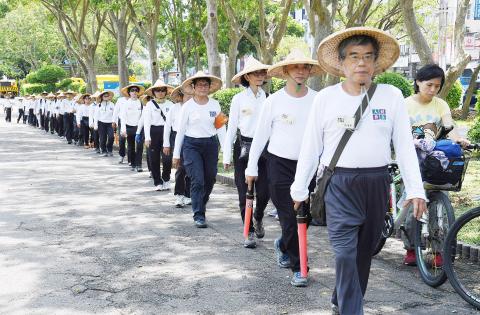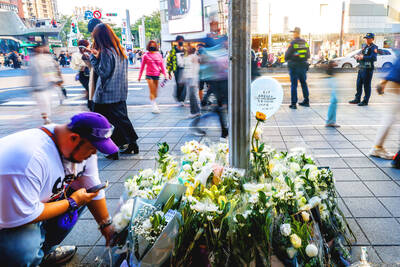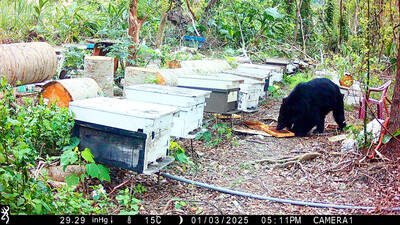About 40 members of the People Rule Foundation yesterday marched in Taipei in a silent appeal to President Tsai Ing-wen (蔡英文) to honor her promise to amend the Referendum Act (公民投票法) by the end of the year, which they said is an important step toward “normalizing” the nation.
Setting out in the morning from MRT Yuanshan Station, the marchers passed the Dadaocheng (大稻埕) area before reaching the Legislative Yuan, their final destination, concluding a walk of about 15km that lasted almost seven hours.
Wearing white T-shirts and bamboo hats, the marchers followed an approach the foundation described as “nonviolent protest,” walking in silence until they arrived in front of the legislature, where they rallied and shouted slogans.

Photo: CNA
Foundation chief executive officer Liu Ming-hsin (劉明新) called on lawmakers to swiftly pass a proposed amendment to the act, which passed its first reading in December last year.
The proposed amendment would lower the number of signatures required to decide the topic of a referendum — the first stage — from 0.5 percent to 0.0001 percent of the total number of eligible voters in presidential elections.
That would bring down the number of signatures needed in the first stage from about 94,000 to about 1,800.
For a signature drive that is held during the second stage of a referendum drive, the threshold for the second stage of a referendum drive to succeed would be brought down to 1.5 percent of the total number of eligible voters in a presidential election, from 5 percent, bringing the requirement down to about 280,000 signatures.
The proposal would abolish the stipulation that a referendum outcome is valid only if more than 50 percent of all eligible voters vote and the “yes” votes account for at least 50 percent of the total number of votes cast.
According to the draft amendment, the outcome of a referendum would be valid if one-fourth of all eligible voters cast a ballot and a majority of votes is in favor of the proposal.
The amendment also seeks to lower the voting age for referendums from 20 to 18.
If the proposed amendment is passed, it would give the nation an “amulet” that would allow the people to decide whether to amend the Constitution to grant Taiwan the status of a “normalized nation,” thereby defending it from the “bullying of foreign forces,” Liu said.
“By amending the act, we would be able to enlighten the public and return the power to decide on national affairs from lawmakers to the people, realizing true democracy,” Liu said.
He called on Tsai to honor her pledge and urged lawmakers to help the bill clear the legislative floor during the third extraordinary session starting on Aug 21 or the next legislative session starting in September.

SHIPS, TRAINS AND AUTOMOBILES: The ministry has announced changes to varied transportation industries taking effect soon, with a number of effects for passengers Beginning next month, the post office is canceling signature upon delivery and written inquiry services for international registered small packets in accordance with the new policy of the Universal Postal Union, the Ministry of Transportation and Communications said yesterday. The new policy does not apply to packets that are to be delivered to China, the ministry said. Senders of international registered small packets would receive a NT$10 rebate on postage if the packets are sent from Jan. 1 to March 31, it added. The ministry said that three other policies are also scheduled to take effect next month. International cruise ship operators

HORROR STORIES: One victim recounted not realizing they had been stabbed and seeing people bleeding, while another recalled breaking down in tears after fleeing A man on Friday died after he tried to fight the knife-wielding suspect who went on a stabbing spree near two of Taipei’s busiest metro stations, Taipei Mayor Chiang Wan-an (蔣萬安) said. The 57-year-old man, identified by his family name, Yu (余), encountered the suspect at Exit M7 of Taipei Main Station and immediately tried to stop him, but was fatally wounded and later died, Chiang said, calling the incident “heartbreaking.” Yu’s family would receive at least NT$5 million (US$158,584) in compensation through the Taipei Rapid Transit Corp’s (TRTC) insurance coverage, he said after convening an emergency security response meeting yesterday morning. National

PLANNED: The suspect visited the crime scene before the killings, seeking information on how to access the roof, and had extensively researched a 2014 stabbing incident The suspect in a stabbing attack that killed three people and injured 11 in Taipei on Friday had planned the assault and set fires at other locations earlier in the day, law enforcement officials said yesterday. National Police Agency (NPA) Director-General Chang Jung-hsin (張榮興) said the suspect, a 27-year-old man named Chang Wen (張文), began the attacks at 3:40pm, first setting off smoke bombs on a road, damaging cars and motorbikes. Earlier, Chang Wen set fire to a rental room where he was staying on Gongyuan Road in Zhongzheng District (中正), Chang Jung-hsin said. The suspect later threw smoke grenades near two exits

The Forestry and Nature Conservation Agency yesterday launched a gift box to market honey “certified by a Formosan black bear” in appreciation of a beekeeper’s amicable interaction with a honey-thieving bear. Beekeeper Chih Ming-chen (池明鎮) in January inspected his bee farm in Hualien County’s Jhuosi Township (卓溪) and found that more than 20 beehives had been destroyed and many hives were eaten, with bear droppings and paw prints near the destroyed hives, the agency said. Chih returned to the farm to move the remaining beehives away that evening when he encountered a Formosan black bear only 20m away, the agency said. The bear